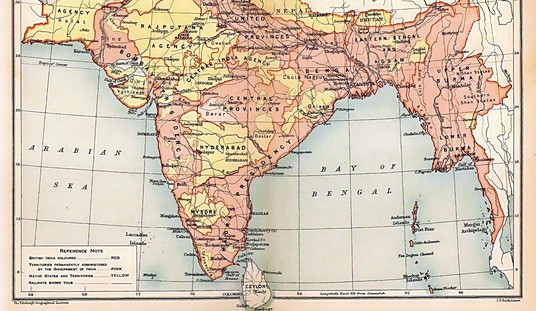With another close national election looming, we seem headed towards another election night where most states are spoken for and just a few battlegrounds like Ohio, Colorado, Virginia, Nevada, and Florida will choose the next president.
The conventional wisdom about the familiar divisions of Democratic “blue” states located mostly on both coasts versus Republican “red” states in mostly the South and the Heartland is that the phenomenon is based mainly on social issues. Michael Barone, co-author of The Almanac of American Politics, has argued for years that social or cultural issues like abortion, gay rights, gun control, and minority rights have been more important than economics since the 1960s in determining Americans’ votes. On the other hand, Democratic strategists like James Carville have always believed that Democrats win by focusing on economic issues. And in the conclusion to The Emerging Republican Majority (1969), Kevin Phillips wrote: “Thus, it is appropriate that much of the emerging Republican majority lies in the top growth states or new suburbia, while Democratic trends correlate with stability and decay.”
As we shall see, Carville and Phillips have a point: as the South has gotten wealthier, it has become more Republican; as the North has lost economic clout, it has moved towards the Democrats in the last generation.
But Mr. Barone and the other “culture war” theorists also have a point. In 2008, President Obama carried eight of the top ten states in per capita income, losing only Dick Cheney’s Wyoming and Sarah Palin’s Alaska (both with substantial energy wealth). Furthermore, the 2008 exit polls showed that red-state voters were more likely to attend church services regularly, and to oppose abortion, gay rights, and gun control.
So, obviously, social issues count in a mostly middle-class nation. But what if there was more to it than that; what if economics still played a major role? Not in the sense of total wealth, but in the direction that state and regional economies are going? What if economic growth patterns reinforced the cultural divisions?
To examine this theory, we can compare the per capita income figures for the South, mountain states, New England, and the big-city states of the Northeast and Midwest like New York, Pennsylvania, and Illinois. We’ll use data from the censuses of 1930 (just as the Depression was beginning), 1950 (the first post-Depression census), 1980 (when Ronald Reagan won big and the South began to permanently move into the Republican coalition at the presidential level), and in the latest census of 2010 (when the state divisions into red and blue are firmly established).
We compare the per capita income of these states and regions to the national average as their percentage of the national average. For example, New York is nicknamed the “Empire State.” That term was highly accurate in the 1930 census as New York’s per capita income was 165% of the national average, by far the best of any state. Perhaps we shouldn’t be surprised that New York voted Republican in seven of the eight presidential elections from 1900 to 1929. The patterns in Illinois (137%), Michigan (110%), Ohio (110%), Pennsylvania (113%), and New England (110%) were very similar.
By contrast, South Carolina (per capita income just 37% of the national average) and Mississippi (just 40%) were the two poorest states in America. Obviously, the memory of the Civil War where two Republicans, President Lincoln and General Grant, ravaged Dixie locked these two Southern states into the Democratic Party, but economics played a role, too. Since the South (with a per capita income only 52% of the national average in 1930) was the poorest region, Southerners would disproportionately benefit from Franklin D. Roosevelt’s New Deal social programs. Indeed, FDR called the poverty of the South the greatest long-term social-economic problem facing the nation. Both the Civil War tradition of a Democratic South facing a Republican North and poverty in Dixie kept the South in the Democratic orbit.
For roughly a century after the Civil War era, from the 1850s to 1956, the South was the Democrats’ best region. But in the 1960s, the Democratic vote for president in Dixie collapsed from 50% in 1960 to only 31% in 1968. Virtually all historians blame the Southern defection on the civil rights movement that eventually forced federal intervention in the “Southern way of life,” i.e., segregation. (The proof offered is that after signing the Civil Rights Act in 1964, Lyndon Johnson, a native Texan, ran worse among white Southerners than did Adlai Stevenson and John Kennedy, both Yankees. Johnson reportedly said after signing the bill: “I’ve just handed the South to the Republican Party for the next 50 years”).
Since the 1960s, Jimmy Carter in 1976 is the only Democratic candidate to carry a majority of Southern states. Social issues obviously played a decisive role, but economics may be the overlooked factor. As noted above, Southern regional incomes were barely half of the national average in 1930. But after the war-time boom of the 1940s, the South had risen to 68% of the national average by the 1950 census. Was it a coincidence that Republican Dwight Eisenhower carried the three wealthiest Southern states (Texas, Florida, and Virginia, respectively) in 1952? And the South’s economic advance would continue.
The Civil Rights Acts of the 1960s helped bring the South into the national mainstream, and the South also aggressively courted industrial development with low taxes and keeping unions out. By the end of the 1960s, a “New South” of booming metropolitan growth, new industries, white collar employment, Yankee migrants (both young and old), central air conditioning, low business costs, and improved race relations had bloomed permanently. In the 1980 census, Southern per capita incomes had reached 84% of the American average. Sure enough, Georgia native Jimmy Carter lost every Southern state except his own to Reagan that year. By 2008 (the last year that figures are available for), Southern regional incomes had reached 89% of the national average. And if we factor in the lower housing costs and less taxes, the Southern standards of living are probably equal to the national average for the first time ever. Over the last generation, a majority of Southern states have voted for Republican nominees in every election. Southern social conservatism combined with an economic boom has made the South a Republican stronghold.
If rising standards of living in the South have helped turn the region Republican, the big states of the North are going in the opposite direction. Led by New York and Illinois, the states that contained the ten largest Frost Belt cities (New York, Chicago, Philadelphia, Detroit, Cleveland, St. Louis, Baltimore, Boston, Pittsburgh, and Milwaukee, respectively) in the 1930 census had per capita incomes that were 117% of the national average. By 1950, that figure had dropped slightly to 109%.
In 1980, the big-city states were down to 103%, where they have pretty much stayed for the past 30 years. Given that these states also have higher taxes and living costs, it can be accurately said that their standard of living has stagnated. New York, which was 65% wealthier than the national average at the end of the “Roaring Twenties,” was only 8% wealthier by 1980. Michigan, with its famous problems of the auto industry in Detroit, has seen its relative wealth decline a stunning 20 points (107% of the national average to 87%) from the 1950 census to the 2010 census, the worst drop of any big state. The story in New England is much the same as their relative incomes have also stagnated. Perhaps we should not be surprised then that the last Republican nominee to carry a majority of these states was the first George Bush in 1988.
The eight states of the Mountain West region also help bolster this economic theory. In the 1930 census, the Mountain states had only 87% of the national average income. Accordingly, they voted for FDR and Truman five straight times. But by 1950, the incomes of the Mountain West had equaled the national average and this booming new middle class helped Republican nominees carry a majority in the region in every election except 1964 for the next 40 years, in fact shutting out the Democrats in the presidential elections of 1952, 1956, 1968, 1972, 1976, 1980, 1984, and 1988.
By the 1990s however, immigration from the Third World (mostly Latin America) had caused the per capita incomes of the Mountain region states to drop below the national average again (to 93% in the latest Census). Since 1990, Democrats, with the help of independent candidate Ross Perot in 1990s, have become very competitive in the Mountain region again, getting shut out only in 2004.
So the “Frost Belt” has lost relative economic strength since the days of FDR and has drifted away from the Republicans. The South has posted huge economic gains in the same time frame and is now part of the Republican base. The Mountain West, intriguing as always, went Republican in the 1950s when their incomes began to equal the national average and stayed in the Republican fold for the next four decades, but began to drift away from the GOP in the early 1990s when immigration helped once again make the region poorer than the national average.
James Carville, Bill Clinton’s successful campaign manager in 1992, famously proclaimed: “It’s the economy, stupid.” Mr. Carville’s wisdom lives on — it looks like political destinies in the 21st century are largely shaped by whether a state’s economy is on the way up or down.









Join the conversation as a VIP Member